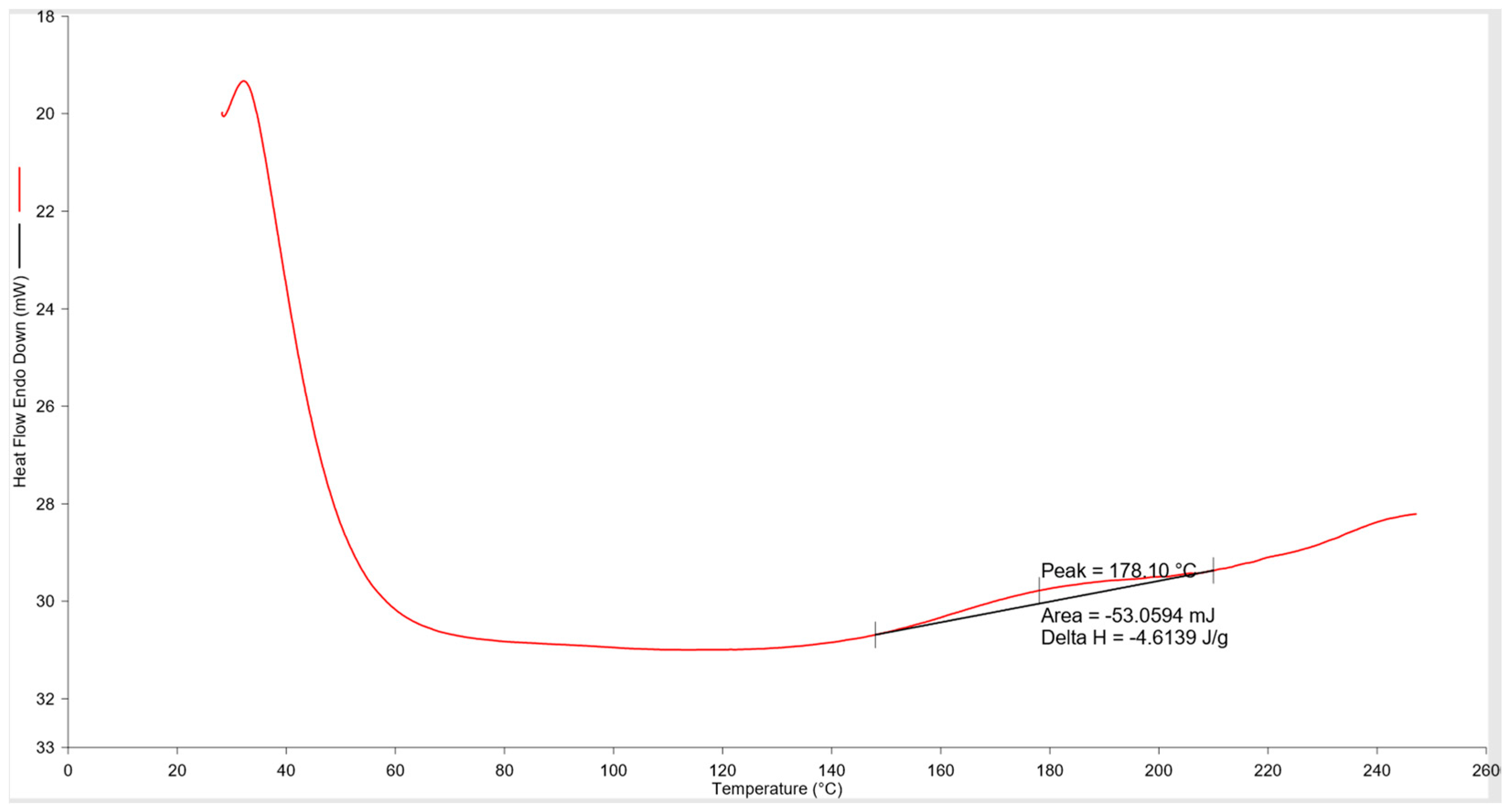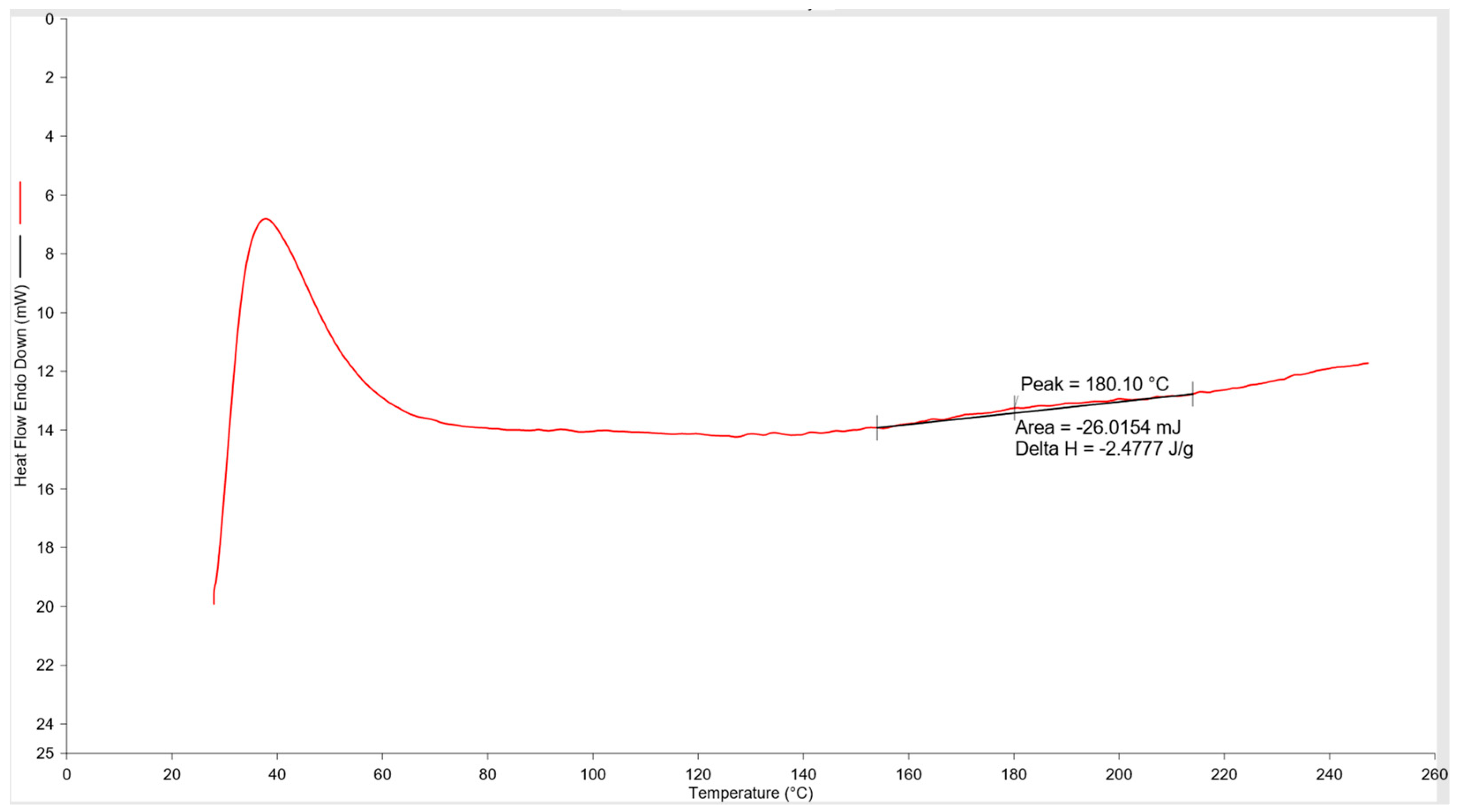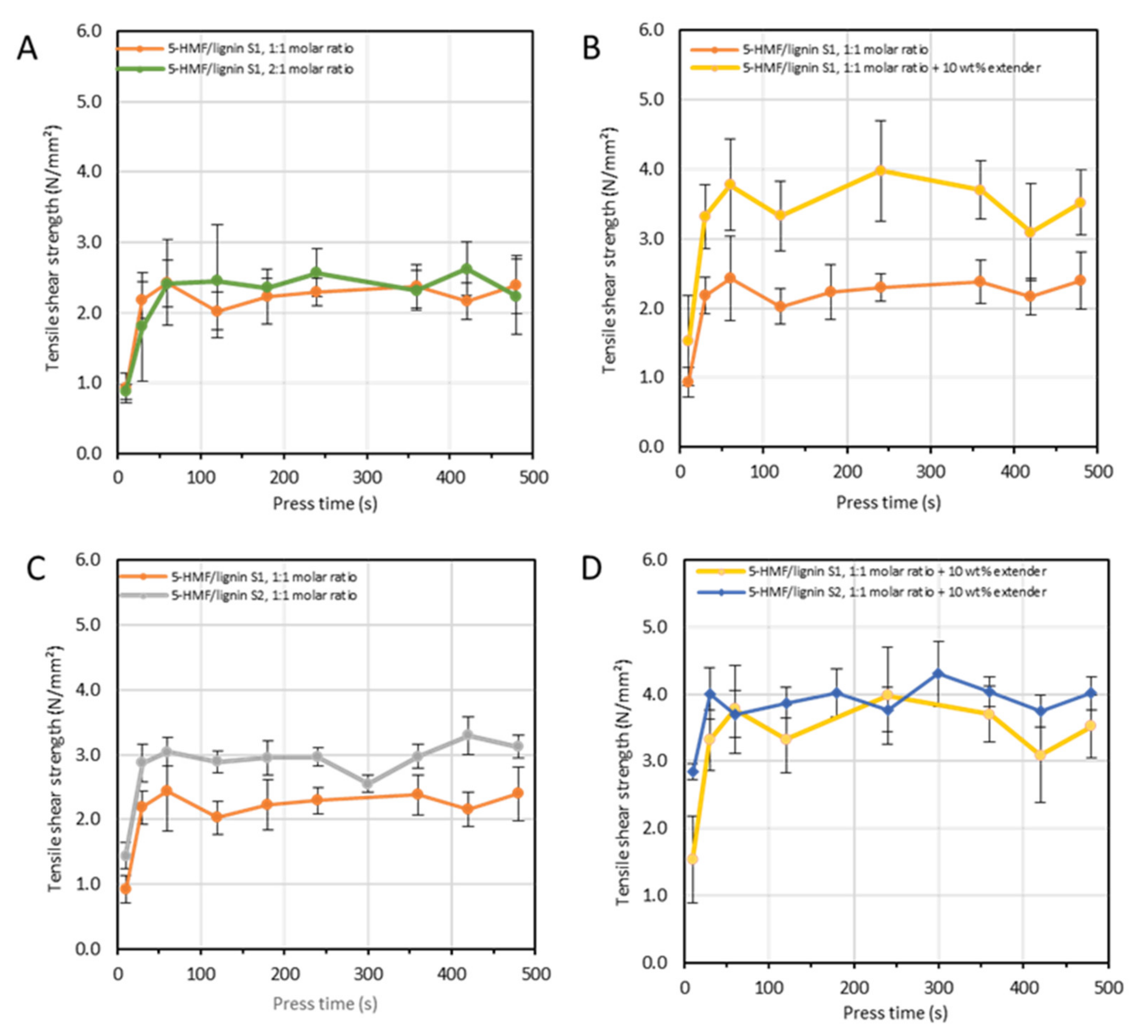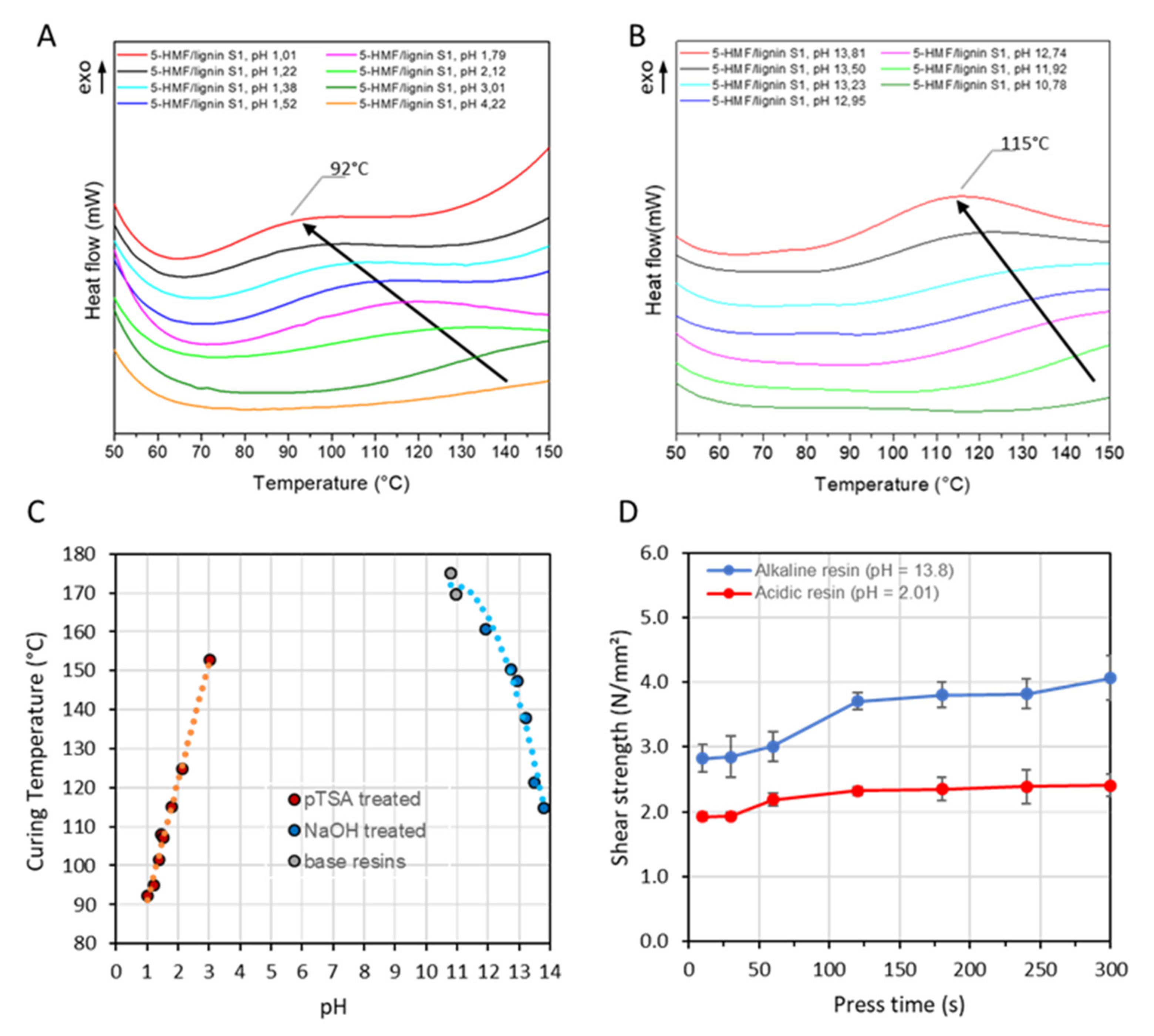Exploring Fully Biobased Adhesives: Sustainable Kraft Lignin and 5-HMF Adhesive for Particleboards
Abstract
1. Introduction
2. Materials and Methods
2.1. Materials
2.2. Resin Preparation
2.3. Viscosity Evaluation
2.4. Filler and Extender Content
2.5. Particleboard Preparation
2.6. Thermal Characterization of the Resin
2.7. Bonding Evaluation
2.8. Moisture Evaluation
2.9. Particleboard Evaluation
3. Results and Discussion
3.1. Adhesive Development
3.2. Adhesive Optimisation
3.3. Particleboard Production and Testing
4. Conclusions
5. Patents
Author Contributions
Funding
Data Availability Statement
Acknowledgments
Conflicts of Interest
Appendix A
- Place 92.9 g of NaOH (50% solid content) and 326.6 g of distilled water in a three-neck round-bottom flask equipped with a condenser, thermometer and stirrer.
- Heat the three-neck round bottom flask to 90 °C.
- Add portion-wise 279.0 g of Kraft lignin (93.64% solid content) to the solution in the three-neck round bottom flask.
- Leave the mixture to stir for 20 min in the three-neck round bottom flask at 90 °C.
- Prepare a 5-HMF solution by adding 223.9 g of solid 5-HMF to 577.6 g of an aqueous 5-HMF solution (25 wt%) and mix the 5-HMF solution thoroughly.
- Add the 5-HMF solution under reflux conditions via a syringe pump with an injection rate of 13.2 mL/min to the solution in the three-neck round bottom flask at 90 °C.
- Once the addition is complete, leave the mixture at 90 °C for 60 min under stirring.
- Cool the resin immediately via insertion into an ice bath.
Appendix B
| Board ID | Days Since Blending (d) | Dry Resin Content (wt%) | Extender Content (wt%) | Filler Content (wt%) | Adhesive’s Total Solid Content (wt%) | Adhesive on Wood Particles (wt%) | Target Mat Moisture Content (%) | Water Spray (g/m2) | Press Closing Time (s) | Press Factor (s/mm) | Produced Viable Board |
|---|---|---|---|---|---|---|---|---|---|---|---|
| 1 | 0 | 35 | 7 | 10.5 | 52.5 | 10 | 12 | 0 | 15 | 15 | No |
| 2 | 0 | 35 | 7 | 10.5 | 52.5 | 10 | 12 | 0 | 15 | 30 | Yes |
| 3 | 1 | 35 | 7 | 10.5 | 52.5 | 10 | 12 | 0 | 15 | 30 | Yes |
| 4 | 1 | 35 | 7 | 10.5 | 52.5 | 10 | 12 | 0 | 15 | 15 | No |
| 5 | 1 | 35 | 7 | 10.5 | 52.5 | 10 | 12 | 0 | 15 | 22.5 | No |
| 6 | 0 | 35 | 7 | 10.5 | 52.5 | 10 | 12 | 0 | 15 | 22.5 | No |
| 7 | 0 | 35 | 7 | 10.5 | 52.5 | 10 | 12 | 0 | 5 | 30 | No |
| 8 | 0 | 35 | 7 | 10.5 | 52.5 | 10 | 12 | 0 | 5 | 22.5 | No |
| 9 | 0 | 35 | 7 | 10.5 | 52.5 | 10 | 12 | 0 | 5 | 30 | No |
| 10 | 0 | 35 | 7 | 10.5 | 52.5 | 10 | 12 | 0 | 5 | 30 | Yes |
| 11 | 0 | 35 | 7 | 10.5 | 52.5 | 10 | 12 | 0 | 15 | 30 | Yes |
| 12 | 0 | 35 | 7 | 10.5 | 52.5 | 10 | 12 | 0 | 5 | 37.5 | Yes |
| 13 | 0 | 35 | 7 | 10.5 | 52.5 | 10 | 12 | 0 | 5 | 45 | Yes |
| 14 | 0 | 35 | 7 | 10.5 | 52.5 | 13 | 12 | 0 | 15 | 30 | Yes |
| 15 | 0 | 35 | 7 | 10.5 | 52.5 | 10 | 10 | 0 | 15 | 30 | Yes |
| 16 | 0 | 35 | 7 | 10.5 | 52.5 | 10 | 10 | 0 | 15 | 37.5 | Yes |
| 17 | 0 | 35 | 7 | 10.5 | 52.5 | 10 | 10 | 25 | 15 | 37.5 | Yes |
| 18 | 0 | 35 | 7 | 10.5 | 52.5 | 10 | 10 | 50 | 15 | 37.5 | Yes |
| 19 | 0 | 35 | 7 | 10.5 | 52.5 | 10 | 10 | 0 | 5 | 37.5 | Yes |
| 20 | 0 | 35 | 9 | 13.5 | 57.5 | 10 | 9.5 * | 0 | 5 | 37.5 | Yes |
| 21 | 0 | 35 | 10 | 15 | 60 | 10 | 9.1 * | 0 | 5 | 37.5 | Yes |
Appendix C




Appendix D

References
- FAOSTAT. Available online: https://www.fao.org/faostat/en/#data/FO (accessed on 5 May 2023).
- Irle, M.; Barbu, M.; Niemz, P.; Carvalho, L.; Martins, J.; Costa, C.; Muszyski, L.; Launey, M.; Sernek, M.; Dunky, M.; et al. Wood-Based Panels an Introduction for Specialists; Thoemen, H., Irle, M., Sernek, M., Eds.; Brunel University Press: London, UK, 2010; ISBN 978-1-902316-82-6. [Google Scholar]
- Wong, E.D.; Zhang, M.; Wang, Q.; Kawai, S. Formation of the density profile and its effects on the properties of fiberboard. J. Wood Sci. 2000, 46, 202–209. [Google Scholar] [CrossRef]
- Dunky, M. Adhesives in the Wood Industry in Handbook of Adhesive Technology, Second Edition, Revised and Expanded, 2nd ed.; Pizzi, A., Mittal, K.L., Eds.; CRC Press: Boca Raton, FL, USA, 2003; pp. 872–941. ISBN 0-8247-0986-1. [Google Scholar]
- Papadopoulou, E.; Nakos, P.; Tsiantzi, S.; Athanassiadou, E.; Chimar Hellas, S.A. The challenges of Bio-adhesives for the wood composite industries. In Proceedings of the 9th Pacific Rim Bio-Based Composites Symposium, Rotorua, New Zealand, 5–8 November 2008. [Google Scholar]
- WHO. WHO Guidelines for Indoor Air Quality: Selected Pollutants; WHO Regional Office for Europe: Copenhagen, Denmark, 2010. [Google Scholar]
- The European Commission. Commission Regulation (EU) No 605/2014; Official Journal of the European Union: Luxembourg, 2014. [Google Scholar]
- Deutsches Institut für Normung. Holzwerkstoffe zur Verwendung im Bauwesen-Eigenschaften, Bewertung der Konformität und Kennzeichnung; EN 13986:2004+A1:2015; Beuth Verlag GmbH: Berlin, Germany, 2015. [Google Scholar]
- Arias, A.; González-García, S.; González-Rodríguez, S.; Feijoo, G.; Moreira, M.T. Cradle-to-gate Life Cycle Assessment of bio-adhesives for the wood panel industry. A comparison with petrochemical alternatives. Sci. Total Environ. 2020, 738, 140357. [Google Scholar] [CrossRef] [PubMed]
- Kristak, L.; Antov, P.; Bekhta, P.; Lubis, M.A.; Iswanto, A.H.; Reh, R.; Sedliacik, J.; Savov, V.; Taghiyari, H.R.; Papadopoulos, A.N.; et al. Recent progress in ultra-low formaldehyde emitting adhesive systems and formaldehyde scavengers in wood-based panels: A review. Wood Mater. Sci. Eng. 2022, 18, 763–782. [Google Scholar] [CrossRef]
- Solt, P.; Konnerth, J.; Gindl-Altmutter, W.; Kantner, W.; Moser, J.; Mitter, R.; van Herwijnen, H.W. Technological performance of formaldehyde-free adhesive alternatives for particleboard industry. Int. J. Adhes. Adhes. 2019, 94, 99–131. [Google Scholar] [CrossRef]
- Pizzi, A.; Kumar, R.N. Adhesives for Wood and Lignocellulosic Materials; Scrivener Publishing LLC: Beverly, MA, USA, 2019. [Google Scholar]
- Hussin, M.H.; Abd Latif, N.H.; Hamidon, T.S.; Idris, N.N.; Hashim, R.; Appaturi, J.N.; Brosse, N.; Ziegler-Devin, I.; Chrusiel, L.; Fatriasari, W.; et al. Latest advancements in high-performance bio-based wood adhesives: A critical review. J. Mater. Res. Technol. 2022, 21, 3909–3946. [Google Scholar] [CrossRef]
- Stubdrup, K.; Karlis, P.; Roudier, S.; Delgado Sancho, L. Best Available Techniques (BAT) Reference Document for the Production of Wood based Panels; JRC Science for Policy Report; Publications Office of the European Union: Luxembourg, 2016.
- McCracken, T.S. PMDI Prepolymers for Enhanced Curing for Production of Wood Composite Panels; Coatings World: Columbia, MD, USA, 2019. [Google Scholar]
- Ghorbani, M.; Liebner, F.; Van Herwijnen, H.W.; Pfungen, L.; Krahofer, M.; Budjav, E.; Konnerth, J. Lignin phenol formaldehyde resoles: The impact of lignin types on adhesive properties. BioResources 2016, 11, 6727–6741. [Google Scholar] [CrossRef]
- Vishtal, A.; Kraslawski, A. Challenges in industrial applications of technical lignins. BioResources 2011, 6, 3547–3568. [Google Scholar] [CrossRef]
- Demuner, I.F.; Colodette, J.L.; Demuner, A.J.; Jardim, C.M. Biorefinery review: Wide-reaching products through kraft lignin. BioResources 2019, 14, 7543–7581. [Google Scholar] [CrossRef]
- Kalami, S.; Arefmanesh, M.; Master, E.; Nejad, M. Replacing 100% of phenol in phenolic adhesive formulations with lignin. J. Appl. Polym. Sci. 2017, 134, 45124. [Google Scholar] [CrossRef]
- Wisa-Biobond. Available online: https://www.wisaplywood.com/wisa-biobond/ (accessed on 15 May 2023).
- Laurichesse, S.; Avérous, L. Chemical modification of lignins: Towards biobased polymers. Prog. Polym. Sci. 2014, 39, 1266–1290. [Google Scholar] [CrossRef]
- Menegazzo, F.; Ghedini, E.; Signoretto, M. 5-Hydroxymethylfurfural (HMF) Production from Real Biomasses. Molecules 2018, 23, 2201. [Google Scholar] [CrossRef] [PubMed]
- Fabbri, F.; Bischof, S.; Mayr, S.; Gritsch, S.; Jimenez Bartolome, M.; Schwaiger, N.; Guebitz, G.M.; Weiss, R. The Biomodified Lignin Platform: A Review. Polymers 2023, 15, 1694. [Google Scholar] [CrossRef] [PubMed]
- Zhang, Y. Production and Applications of Formaldehyde-Free Phenolic Resins Using 5-Hydroxymethylfurfural Derived from Glucose In-Situ. Ph.D. Thesis, The University of Western Ontario, London, ON, Canada, 2014. [Google Scholar]
- Balakshin, M.; Capanema, E. On the Quantification of Lignin Hydroxyl Groups With 31P and 13C NMR Spectroscopy. J. Wood Chem. Technol. 2015, 35, 220–237. [Google Scholar] [CrossRef]
- Ferreira, A.M.; Pereira, J.; Almeida, M.; Ferra, J.; Paiva, N.; Martins, J.; Magalhães, F.D.; Carvalho, L.H. Biosourced Binder for Wood Particleboards Based on Spent Sulfite Liquor and Wheat Flour. Polymers 2018, 10, 1070. [Google Scholar] [CrossRef]
- Chen, Y.; Cai, T.; Dang, B.; Wang, H.; Xiong, Y.; Yao, Q.; Wang, C.; Sun, Q.; Jin, C. The properties of fibreboard based on nanolignocelluloses/CaCO3/PMMA composite synthesized through mechano-chemical method. Sci. Rep. 2018, 8, 5121. [Google Scholar] [CrossRef] [PubMed]






| Kraft Lignin | Aliphatic OH mmol/g | Phenolic OH mmol/g |
|---|---|---|
| S1 | 2.72 | 4.49 |
| S2 | 2.66 | 4.45 |
| 5-HMF/Lignin S1 Molar Ratio | Gel Time (min) | pH | Solid Content |
|---|---|---|---|
| 0.7 | 16 | 10.8 | 34.1 |
| 1 | 9 | 10.5 | 40.9 |
| 1.5 | 11 | 10.2 | 44.2 |
| 2 | 18 | 10.0 | 49.5 |
| 3 | 42 | 9.6 | 56.1 |
Disclaimer/Publisher’s Note: The statements, opinions and data contained in all publications are solely those of the individual author(s) and contributor(s) and not of MDPI and/or the editor(s). MDPI and/or the editor(s) disclaim responsibility for any injury to people or property resulting from any ideas, methods, instructions or products referred to in the content. |
© 2023 by the authors. Licensee MDPI, Basel, Switzerland. This article is an open access article distributed under the terms and conditions of the Creative Commons Attribution (CC BY) license (https://creativecommons.org/licenses/by/4.0/).
Share and Cite
Dorn, L.; Thirion, A.; Ghorbani, M.; Olaechea, L.M.; Mayer, I. Exploring Fully Biobased Adhesives: Sustainable Kraft Lignin and 5-HMF Adhesive for Particleboards. Polymers 2023, 15, 2668. https://doi.org/10.3390/polym15122668
Dorn L, Thirion A, Ghorbani M, Olaechea LM, Mayer I. Exploring Fully Biobased Adhesives: Sustainable Kraft Lignin and 5-HMF Adhesive for Particleboards. Polymers. 2023; 15(12):2668. https://doi.org/10.3390/polym15122668
Chicago/Turabian StyleDorn, Liam, Arthur Thirion, Masoumeh Ghorbani, Luis M. Olaechea, and Ingo Mayer. 2023. "Exploring Fully Biobased Adhesives: Sustainable Kraft Lignin and 5-HMF Adhesive for Particleboards" Polymers 15, no. 12: 2668. https://doi.org/10.3390/polym15122668
APA StyleDorn, L., Thirion, A., Ghorbani, M., Olaechea, L. M., & Mayer, I. (2023). Exploring Fully Biobased Adhesives: Sustainable Kraft Lignin and 5-HMF Adhesive for Particleboards. Polymers, 15(12), 2668. https://doi.org/10.3390/polym15122668








